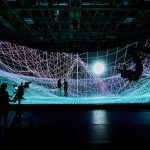A look at the impact of AI technology on TV broadcast, and where it could take the industry.
Hailed by some as the next industrial revolution, AI is already disrupting the broadcast industry. For instance, the latest Disney+ Marvel series, Secret Invasion, opens with an AI-generated title sequence. The NFL also used Respeecher, a deep-learning audio tool, to recreate the voice of deceased football coach Vince Lombardi for the Super Bowl.
For both on- and off-set talent, these types of changes might be alarming. British radio and TV presenter Greg James recently said he was afraid that his career would be rendered obsolete with the rise of ChatGPT and the prospect of “AI robots who will become better, funnier, cleverer, and at the fraction of the price of human beings on screen”. In the midst of new AI tools that enhance production and efficiency, there is growing uncertainty on how AI may replace jobs and workflows in the near future.
After over a decade of working with broadcasters like NBC, CNN and Univision, I can understand why disruptive technologies like AI can be concerning. But I also believe that AI will have a more positive effect than the headlines might have you believe. Yes, just like the internet, the potential of AI is vast and that can be pretty scary. But if we integrate it correctly and make sure the right education and safety regulations are in place, it is likely to be transformative. Below are some benefits where AI can take the broadcast industry to new frontiers and bring more value to viewers.
More engaging content
With AI, we’re seeing a more interactive approach to production. It’s easier than ever for on-set talent to interact with a virtual character, because AI can track them and use that data to drive the motion of the virtual character. At disguise, we recently teamed up with Move.ai to create Invisible, a real-time markerless motion capture solution that helps broadcasters to do just that. This type of AI improves efficiency by reducing set-up times, lowers cost by removing the need for expensive suits and equipment, and limits the number of repetitive clean-up tasks by extracting natural human motion from performances.
Our team has also been playing around with the capabilities of Adobe Firefly, a tool that allows you to create generative content for video production or replace content. Therefore, if you have a physical performance caught on camera, you can use that performance to power an animated character, or even replace that performer with a virtual one in the shot.
For off-set talent, accessible AI tools like ChatGPT are helping to create more exciting content for audiences. If, for example, a team needs to create a metahuman double of a real person, they could ask ChatGPT for a detailed rundown of their characteristics and physicality. They could even feed that information or photos into another AI tool like HyperHuman to create the 3D model for them, saving days of work.
These are just a few examples of AI technology enabling bigger creative ideas while decreasing the time and money needed to make them a reality. It’s easy to forget just how quickly tools like ChatGPT and Firefly are developing; the former was only released to the public around six months ago. Another year from now, AI could help us do complex tasks like creating digital twins, which currently takes months, in half the time. In five years that could be just a tenth of the time.
Faster production workflows
AI is already making virtual production and 3D graphics easier and cheaper than before. Using transformative AI technology known as NeRFs (neural radiance fields), broadcasters can take images of the real world with the latest iPhone or another high-spec capture device and upload them onto an AI platform (for example, Volinga. ai), then, through workflows like disguise RenderStream, transform that image into a 3D virtual scene in minutes. This lowers the carbon footprint for TV broadcasts, allowing content captured from anywhere in the world to be used in a production in one place. No more building hard sets, shooting on location or making room for lengthy pre- and post-production workflows.
New possibilities for data-driven storytelling
Broadcast is in essence storytelling, and stories are driven by data. Whether it’s the score on a game show or player statistics before a sporting event, the presentation of data helps to frame an audience’s understanding and enjoyment of the content. Here at disguise, much thought is going into how AI could be used to generate or analyse data in new ways in the wider broadcast industry. We could use sports footage to create new data and data visualisations that offer viewers a new perspective, or tailor that perspective to each individual viewer.
Much of the data we see on broadcast TV is created by humans that track and enter it in real time, and now we are seeing that change, with AI- and machine learning-generated data visualised and captured in a new and exciting way. While processes that require imagination and emotion might not be AI’s strongest suit for some time, a task like data analysis could prove an ideal application.
It’s not hard to imagine big sporting organisations like the NFL or Premier League telling compelling stories across the season with AI-gathered footage and information from past events. An AI tool could even record live content and data for use in later broadcasts.
Another ideal application for AI is limiting the number of repetitive and time-consuming tasks for creatives. For example, we’re already seeing MetaHumans on television screens, appearing in shows ranging from esport competitions to virtual song contests. Controlling and animating those characters requires a huge amount of repetitive work that could be automated and realised to a high standard by an AI application.
If this sounds something like a video game, that’s because it almost is. Over the coming years, we’re likely to see video game technology inform broadcast content more and more. A recent example saw the 2023 NHL Winter Classic capture live data from players and use it to create a cartoon that was later broadcast on Nickelodeon. This could bring new, younger audiences to content that they would otherwise not find engaging.
A creative future
Such is the promise of AI that it’s easy to forget just how early in its development we are, with broadcasters and developers still exploring capabilities and limitations. That obviously comes with a certain amount of apprehension. As AI continues to evolve, the risk of content being created to mislead audiences grows. As with any new technology, some way to regulate its use will help to ensure we get the best out of it. There are some accuracy issues, but with more public and private data, the models will only get better and less erroneous. The big elephant in the room, of course, is copyright and ownership of assets created by AI tools. Until there is more industry standardisation and regulation, the terms will be a grey area and up for negotiation. The current potential of AI in broadcast lies in automating repetitive and often solitary tasks. Things like tracking data could, in a few years, be done better and more efficiently thanks to machine learning. Jobs in high demand, those based on creativity, expression and communication, will remain for humans. In fact, advances in AI will allow human creativity to thrive, achieving new heights in broadcast as most repetitive and straightforward content tasks are automated. This will lead to better, more engaging content. I can’t wait to see how things change in the next few years.
 Grigory Mindlin is GM for Broadcast at disguise.
Grigory Mindlin is GM for Broadcast at disguise.
















































































